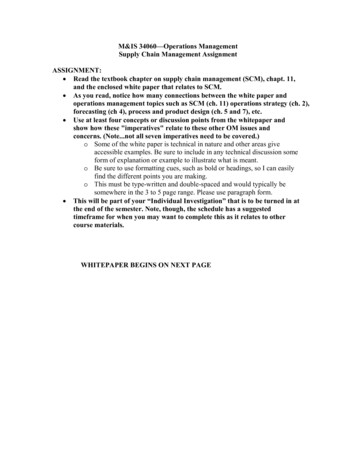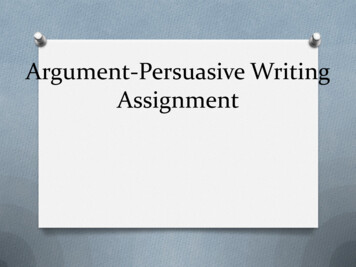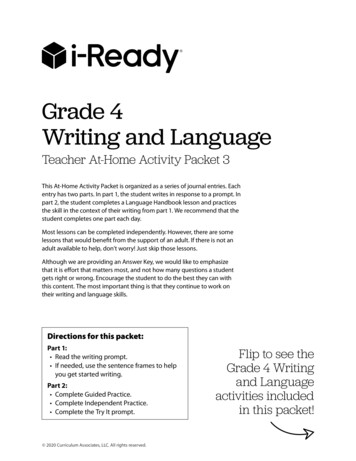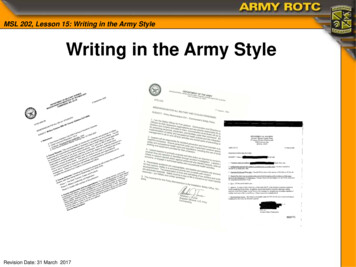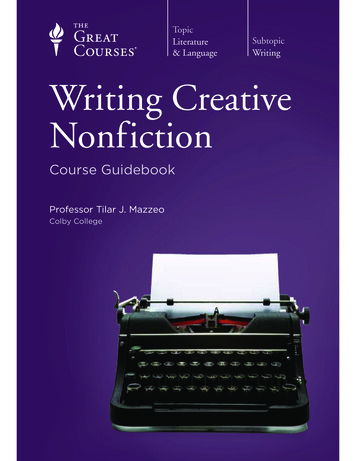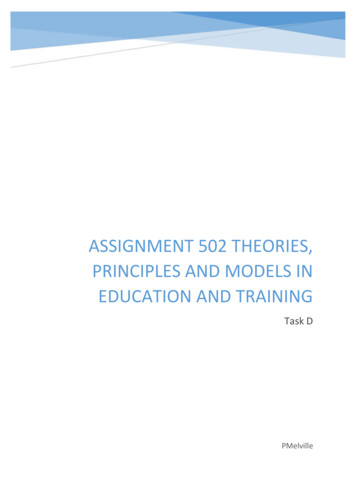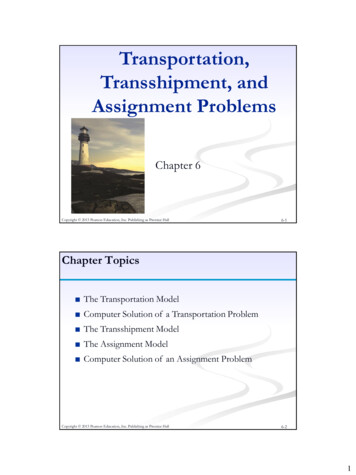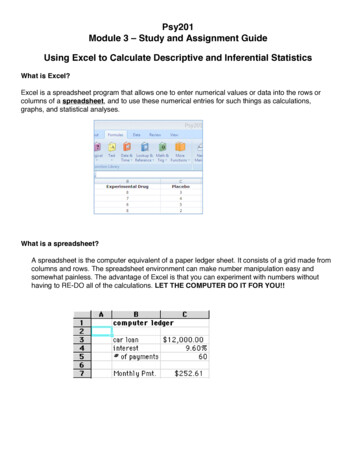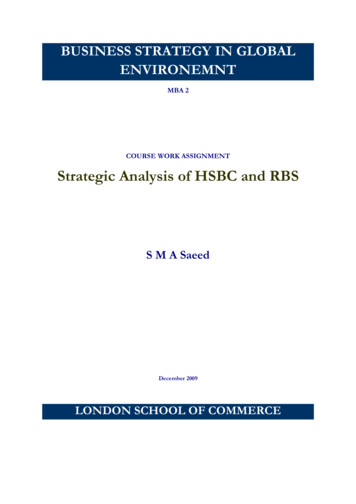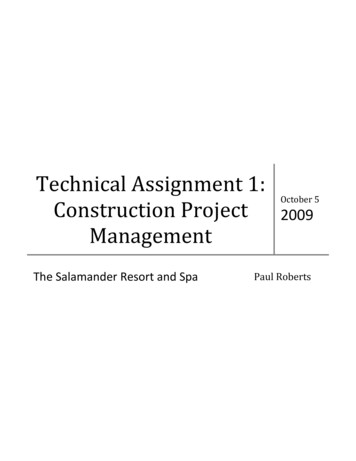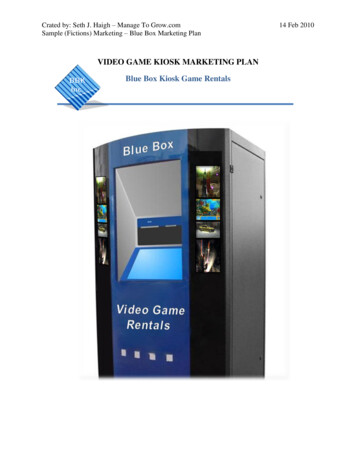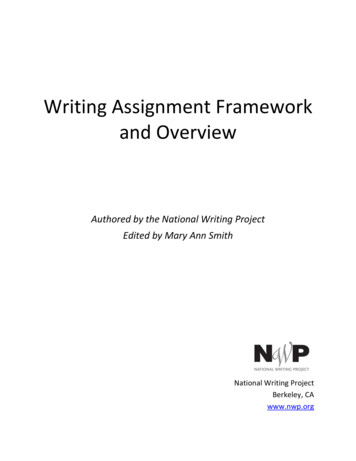
Transcription
Writing Assignment Frameworkand OverviewAuthored by the National Writing ProjectEdited by Mary Ann SmithNational Writing ProjectBerkeley, CAwww.nwp.org
Table of ContentsAcknowledgements . 1Introduction . 2Writing Assignment Framework and Overview . 3Tools for Planning and Reflection . 5Writing Assignment Overview . 6Writing Assignment Framework . 9Professional Development Template . 10Writing Assignment Professional Development Session . 11Sample Assignments and Related Student Work. 16Kindergarten, Writing Exploration . 17Primary, Urban . 28Fourth Grade, Rural . 34Middle School, Suburban, Writing Across the Curriculum . 45High School, Digital, AP, Character Exploration . 56High School, Digital, Reading Response . 66High School, English Learner, Small City . 75High School, English Language Development, Digital, Writing Process . 87Recommended Resources . 98
AcknowledgementsThe National Writing Project gratefully recognizes those individual educators who played anessential role in the creation of the Writing Assignment Framework and Overview and thesupporting materials contained within this document.Writing Assignment Framework and Overview Design TeamLinda Allsup - Mississippi State University Writing/Thinking ProjectAdela Arriaga - Bay Area Writing ProjectSeddrick Bell - Upstate Writing ProjectKim Crawford - Chicago Area Writing ProjectKathy Dudley - Hudson Valley Writing ProjectTracey Freyre - Bay Area Writing ProjectLinda Friedrich - National Writing ProjectDaniel Fuller - Mississippi State University Writing/Thinking ProjectValerie Gina Guess - Mississippi State University Writing/Thinking ProjectLannette Jimmerson - Bay Area Writing ProjectDavid Jolliffe - Consultant, University of ArkansasRebecca Kaminski - Upstate Writing ProjectPaul LeMahieu - National Writing ProjectCarisa Lubeck - National Writing ProjectLynn Olsen - Hudson Valley Writing ProjectKim Patterson - Mississippi State University Writing/Thinking ProjectMarjorie Roemer - Rhode Island Writing ProjectMary Sawyer - Hudson Valley Writing ProjectLaurie Sherman - Rhode Island Writing ProjectMary Ann Smith - National Writing ProjectSherry Swain - National Writing ProjectSue Vanderdoes - Rhode Island Writing ProjectJoe Viveiros - National Writing ProjectRoel Vivit - Chicago Area Writing ProjectCheryl Wozniak - Bay Area Writing ProjectEducators Whose Assignments Are FeaturedAdela ArriagaBrooke DycusTracey FreyreLaura GraceffaMona LehlGerald MountainMichelle WilliamsRaisi Zairel ZambranoCreators of the Professional Development TemplateRebecca KaminskiKim PattersonRoel Vivit1
Introduction³%H FDUHIXO ZKDW \RX DVN IRU RX PLJKW JHW LW V WKLV ROG DGDJH VXJJHVWV RXU PRVW fervent wish has the potential to boomerang, leaving us with some undesirable orunintended consequence. When it comes to the classroom and what we ask of ourstudents, teachers always want the best and most desirable results, with a minimum ofassignments and lessons that conclude with lackluster student work.In the case of teachers who teach writing or teachers who use writing to learn, thechalOHQJH RI GHVLJQLQJ WKH ³DVN IRU ²the invitation to write²is particularly daunting.The sheer number of decisions could daze the most fearless among us: What do I wantmy students to learn from this assignment? For whom are they writing and for whatpurpose? What do I think the final product should look like? What processes will help thestudents? How do I teach and communicate with the students about these matters?These decisions sit at the center of the Writing Assignment Framework and Overviewproject. This project has its roots in a study begun for the Consortium for Chicago SchoolResearch (CCSR) in 1996. Led by Fred Newmann, then a professor at the University ofWisconsin, and supported by the Annenberg Network Challenge, the CCSR studyexamined WHDFKHUV¶ DVVLJQPHQWV DQG VWXGHQW ZRUN emerging from several Chicago publicschools. The basis for this empirical VWXG\ ZDV 1HZPDQQ¶V FRQFHSW RI ³Duthenticintellectual achievement. For a writing assignment to be authentic, the task would askstudents to (a) construct knowledge in contrast to simply reproducing knowledge; (b)elaborate their writing by making generalizations and supporting them with examples,details, or reasons; and (c) connect their work to issues and concerns that prevail beyondWKH VFKRRO¶V ZDOOV Research shows that teachers who give students assignments requiring authenticintellectual work see greater gains on standardized tests (Newmann, Bryk, and Nagaoka2001). Such work is similar to the type of problem solving that adults face in theireveryday lives and helps prepare students to be critical, analytical thinkers.1:3¶V FRPPLWPHQW WR LQYHVWLJDWLQJ DQG GLVVHPLQDWLQJ WKH EHVW DYDLODEOH DQG FODVVURRPtested information about writing assignments began in 1999 with the three-yearNWP/AED VWXG\ RI ³authentic intellectual work" and of the emphasis NWP teachersplace on such work in their assignments. Currently, SRI International is using theauthentic intellectual work framework as an integral component in examining the effectsof local writing project sites¶ SURIHVVLRQDO GHYHORSPHQW RQ WHDFKHUV¶ SUDFWLFHV TheWriting Assignment Framework and Overview are the result of 1:3¶V third study,begun in 2010.The goal of the Writing Assignment Framework and Overview project is to serve as aclassroom and professional development tool²born of research and practice²that willhelp teachers create and refine challenging assignments for students. As always, we seekto support teachers with resources that will ultimately improve student writingperformance.2
Writing Assignment Framework and OverviewPurpose of the Framework and OverviewThe Writing Assignment Framework and Overview represent the effort of NationalWriting Project teachers to create tools for themselves and their colleagues that mightsubstantially strengthen their writing assignments. We know from our own experiencesthat teachers often spend hours designing writing tasks and even more hours reading whatVWXGHQWV KDYH PDGH RI WKRVH WDVNV :H DOVR NQRZ WKDW WKHUH DUH QR ³VXUHILUH DVVLJQPHQWV anywhere that will engage and produce the best thinking from every student. Our tool,then, is not a list of the ten best or the twenty worst writing tasks. Instead, it offers a lensWR ORRN DW DQ DVVLJQPHQW¶V SXUSRVH SOanning and preparation, expectations, andprocesses. You will notice right away that not all the items in the framework apply toeach assignment. Rather, we designed the framework and also the overview to beinclusive, flexible, and adaptable so that teachers might use them in a variety of contentareas and for multiple purposes. Because this tool has been created by teachers forteachers, it is important to say what it is NOT. It is not a checklist or an evaluationinstrument. It is not mandatory, compulsory, or required. It is, however, a tool²born ofresearch and practice²that respects teachers and their continuous efforts to give theirstudents challenging writing assignments.What do we mean by writing assignment?A writing assignment encompasses any writing task a teacher asks of students thatinvolves one or more of the following thought processes: analysis, evaluation,interpretation, narration, synthesis, reflection, clarification, summarization, creativeexpression, and application or demonstration of knowledge or learning.Who are these tools for?These tools are for anyone who invites students to write, and especially for those teacherswho want to learn more about engaging and rigorous learning experiences for students.These teachers include:writing project teacher-consultants;experienced, novice, and preservice teachers;K 12, college, and graduate student teachers;English language arts and content area teachers and teachers of students withspecial needs (English learners, special education).Where might you use the tools?We envision these tools being used in a variety of contexts that could include but are notlimited to: department meetings, professional development days, personalreflection/planning, personal portfolio, grade-level meetings, mentor-teacher meetings,3
department files or notebooks, continuity meetings/seminars/workshops, summerinstitutes, professional learning communities.How might you use the tools?The Writing Assignment Framework and Overview may be used to guide teachers indeveloping assignments that help students demonstrate increasing sophistication in allaspects of language use, as required by the Common Core State Standards.If you and your colleagues decide to examine writing samples together, considercollecting pieces written at various ability levels or in a variety of content areas. Youmight also aim for a wide range of assignments (writing to learn, quickwrites, journalentries, reflection, formal essays, digital compositions, and other projects that involvewriting).If you are using the Writing Assignment Overview as part of your personal planning andreflection, you may wish to add notes about resources, sources or citations, materialsneeded, standards addressed, or other information you would need to remember whenrevisiting an assignment.If you are using these tools as part of your department or school professional planning,consider creating a safe environment first. One way might be to introduce the overviewusing writing samples not connected to anyone in the room. Your community may wantto do several rounds, using a discussion protocol, before asking teachers to bring in theirRZQ VWXGHQWV¶ ZULWLQJ 2QFH you have used the assignment overview a few times withyour RZQ VWXGHQWV¶ work, consider introducing the assignment framework.As you begin to familiarize yourself and your colleagues with the Writing AssignmentFramework, consider focusing on one area of the framework at a time or examining thetop level questions first. You may also want to read some of the professional articles thatprovide the theoretical background and underpinnings (see Recommended Resources.)When using the framework and overview beyond the immediate school community, besure to think about permission slips and/or redacting student names.Work CitedNewmann, Fred, Anthony Bryk and Jenny Nagaoka. 2001. Authentic Intellectual Workand Standardized Tests: Conflict or Coexistence? Chicago: Consortium on ChicagoSchool Research at the University of Chicago.4
Tools for Planning and ReflectionThe following section contains the Writing Assignment Framework and Overview documents.These documents can be used as part of a professional development program as outlined in theProfessional Development Template or as tools for assignment planning and reflection.5
Writing Assignment OverviewThe Writing Assignment Overview is a tool for reflecting on a writing assignment, either by an individualteacher or by a group of teachers. Please make it your own by adding notes and other items fordiscussion and reflection.Assignment Title:Grade level:Date:Subject area:Description of students in my class:Assignment PurposeWhat are the instructional goals for the assignment?Planning and Preparation1. Length of assignment:Completed in a single class periodCompleted within one weekCompleted in weeks2. Who created this assignment?Workshop/professional developmentColleagueDistrict writing programDeveloped it myselfText bookOn-line resourceTeacher guide/resource bookTest prep materialsOther (please specify):3. Is the assignment embedded in a larger instructional plan such as a unit study, district, state orprofessional standards? If so, how?4. If you plan to reflect on your assignment with other colleagues, please describe or attachinformation about how you introduced and taught the assignment. 2011 by the National Writing Project (NWP). All rights reserved.For reprint information, contact permissions@nwp.org or visit ermissions.csp6
Product Expectations1. Criteria for evaluation (if relevant):Audience feedback (e.g., another class, administrators, etc.)ChecklistsRubricSelf scoringOther student scoringTeacher scoring2. What do you expect the product to show about student learning?3. How did you communicate product expectations? If you are sharing this assignment withcolleagues, please provide explanations or examples.Process1. If student planning was necessary for this assignment, please number in the order the activitiesoccurred:DiagrammingBrainstorming (as a class)DrawingBrainstorming (in small groups)Free-writingBrainstorming (individually)Information gatheringClass discussionNote-takingCollaboration among studentsOther (please specify):ConferencingOutliningCreating a web2. Did the assignment involve students creating more than one draft of the written work (e.g.,multiple revisions)?NoYes3. Other notes: 2011 by the National Writing Project (NWP). All rights reserved.For reprint information, contact permissions@nwp.org or visit ermissions.csp7
Written Reflection on the Assignment1. How well did the assignment fulfill my purposes?2. How well did the product fulfill my expectations?3. What worked and why?4. Were any parts of the assignment difficult for students? Please elaborate.5. Were there any surprises in the way students completed the assignment? Please explain.6. What, if anything, would I do differently next time, and why?7. Questions I would like to consider about this assignment or the student work samples. 2011 by the National Writing Project (NWP). All rights reserved.For reprint information, contact permissions@nwp.org or visit ermissions.csp8
Writing Assignment FrameworkAssignment Purpose: What are the instructional goals or reasons for this assignment? What are studentsexpected to know, learn, or be able to do? Some things to consider:ĿĿĿĿHow is the assignment embedded in a larger instructional plan?How is the assignment connected to district, state, or professional standards?How are the purpose and audience of the assignment communicated to students?How does the assignment address a purpose and/or an audience beyond the classroom?Planning and Preparation: How does the teacher plan for the assignment and prepare students to do it? Somethings to consider:ĿĿĿĿĿĿĿWhat theories, concepts, and/or bodies of knowledge does the planning of the assignment draw on?What choices can students make to allow for ownership and authority?What skills, experiences, and processes need to be taught and reinforced so that students can produce the product?Has the teacher written to the assignment or explored the effectiveness of the assignment in other ways?How is the assignment communicated from teacher to students (e.g., orally, in writing, other)?How is the assignment made comprehensible to all students, including accounting for the complexity oflanguage?How is time for the assignment allotted? If relevant, time for prewriting? In-class writing? Continued drafting?Responding?Product expectations: How does the assignment communicate expected levels of performance? Are theremodels of what will make a successful product? Some things to consider:ĿĿĿĿĿĿĿHow and by whom are the criteria for evaluation developed, how are they communicated, and how clearly arethey stated?How are the teaching and learning goals evaluated?Who is involved in assessing the product?When the scope of the assignment is large, what products are expected along the way (e.g., outlines, think pieces,journal entries, drafts)?How does the assignment allow for differentiation (e.g., English learners, special education, gifted and talented,other)?How does the assignment encourage students to go beyond restating, to analyze, synthesize?How does the assignment invite students to write for purposes and/or audiences beyond the classroom?Process: How does the assignment provide opportunities for the writer to engage in a writing or learningprocess? Some things to consider:ĿĿĿĿĿ9How is the assignment, including its purpose, explained and discussed?How are students supported with relevant knowledge bases, resources, materials, prior knowledge, and otherscaffolds to build content?How GRHV WKH SURFHVV SURYLGH RSSRUWXQLWLHV DQG VXSSRUW IRU VWXGHQWV¶ GHFLVLRQV DERXW VWUXFWXUH DQG FRQWHQW" What opportunities exist for review, feedback, and revision?How does the assignment include opportunities for reflection? 2011 by the National Writing Project (NWP). All rights reserved.For reprint information, contact permissions@nwp.org or visit ermissions.csp
Professional Development TemplateThe following Professional Development Template provides a sample IDFLOLWDWRU¶V DJHQGD IRU D one-day session of professional development. The template can be used as is, or refined to bettersuit specific professional development needs.10
Writing Assignment Professional Development Session(1 Day)Rebecca Kaminski, Kim Patterson & Roel VivitHandouts and Materials ³6WDQGDUGV IRU XWKHQWLF FKLHYHPHQW DQG 3HGDJRJ\ * :Hhlage, F.Newmann, & W. Secada (Handout #1) 4 As Protocol (Handout #2) NWP Writing Assignment Framework cut into sections (Handout #3) NWP Writing Assignment Framework (Handout #4) Teacher Assignment Packets (coversheet with attachments and student worksamples); prior to PD session, the facilitator should select from the possibleassignment packets those packets that are a best fit for his/her group. Chart paper, markersNotes about Writing Assessment Professional Development Session Prior to the session, the facilitator should, if possible, email teachers asking themto bring with them a writing assignment and 2 3 student samples resulting fromthe assignment. An assignment may include: lesson plan or outline, writingprompt, materials and/or resources used during the assignment, handouts, etc. If possible, arrange seating in groups of 4 5 at tables. If the professional development is of a shorter duration, the facilitator may chooseto XVH D MLJVDZ DFWLYLW\ IRU UHDGLQJ ³6WDQGDUGV IRU XWKHQWLF FKLHYHPHQW DQG 3HGDJRJ\ XVHG LQ Setting Conceptual Foundation portion. With the 4 As protocol process used in Setting Conceptual Foundation portion,facilitator may
entries, reflection, formal essays, digital compositions, and other projects that involve writing). If you are using the Writing Assignment Overview as part of your personal planning and . Chicago: Consortium on Chicago School Research at the University of Chicago. 4.
